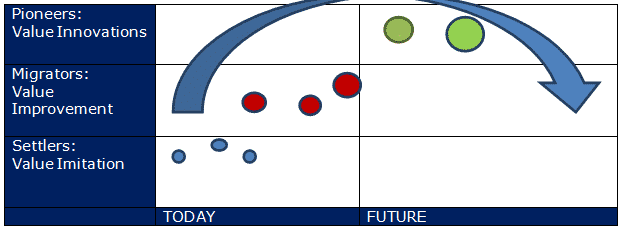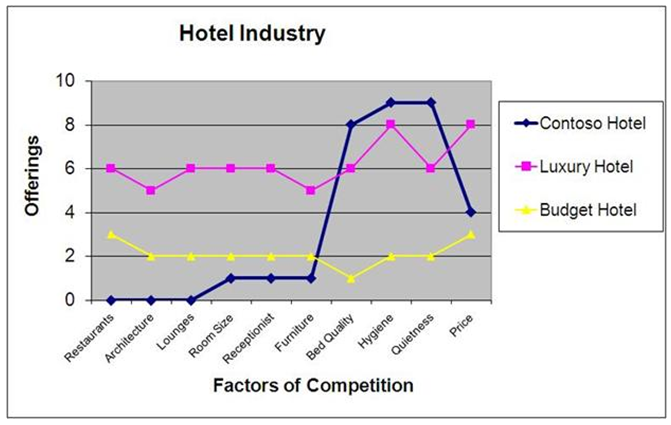How to Do a “Blue Ocean Strategy®?”: Step 1

 After completing my three-day intensive certification as a practitioner of “Blue Ocean Strategy®,” it became clear that the one chapter really missing from the book was the “How to” chapter. This, then, is the blog-size version of that chapter so perhaps you can find your own “Blue Ocean.”
After completing my three-day intensive certification as a practitioner of “Blue Ocean Strategy®,” it became clear that the one chapter really missing from the book was the “How to” chapter. This, then, is the blog-size version of that chapter so perhaps you can find your own “Blue Ocean.”
Let’s begin.
What is the problem you are trying to solve? Typically it’s that your company has stalled or failed to sustain profitable growth, and now you find yourself stuck in a very “red ocean” of bloody competition. The real nemesis here is a business model which pits you against others in your industry. Or the fact that you’ve attended so many trade shows in your own category that you can almost recite by memory what your competition is doing. Or the problem might be that you keep trying to differentiate your business, your talent, your approach, your processes, and your value proposition from others that are really just like you. Trapped in this zero-sum game, you and they are merely dividing up a highly competitive world into winners and also-rans.
To a great extent, the strategic models taught in business schools and preached by the leaders in the field—be they Michael Porter or Peter Drucker or Tom Peters or Jim Collins or the rest—tell you to do your SWOT analysis to see where you are strong (leverage it), weak (address it), have opportunities (capitalize upon) or have threats (need to tackle). You define your market and your target customer segments and go at it—trying to find your point of difference and hold onto it in a way that is meaningful to your customers at a price that gives you a margin.
In Blue Ocean thinking, however, you stop competing altogether. You make the competition irrelevant by not focusing on existing market space. Rather, you “reconstruct” your market space, creating a new market, adding value in highly innovative ways, tackling the unmet needs and demands of nonusers who found solutions in alternatives to your business offerings, and creating demand, not just fulfilling it.
Sounds like something you need to get started with, which is often when our clients discover they need a hand in reinventing themselves. But where to begin? Let’s map out the first part of the journey:
1. The first thing to do is to take stock of where your products and services fit in your own industry. The Blue Ocean tool to use is the “Pioneer, Migrator, Settler” chart (PMS). Here, you can plot your products and services in terms of their degree of competitive innovation, monopolistic positioning, and ability to differentiate their solutions from the market itself. This is a different way to look at what you are offering and how it fits into market needs and demands. Over time, all products and services find themselves pushed back into a “settler” positioning as new products arise and the value you are offering no longer offers solutions in innovative ways.
2. The second thing is to take a good hard look at your company today. Do this by drawing a “Strategic Canvas.” Try doing it for your entire organization or for different lines of business—however your investment strategy is organized. The canvas allows you to see the value you are adding today by plotting your investment against your major competitor(s) along the core areas where the industry is investing today.
Here are two examples:
1. The first is the hotel industry and the Contoso Hotel.
What is clear here is that high-priced luxury hotels—the Contoso’s rivals—are well-invested in the key factors of competition. The budget hotels are not distinguishing themselves except as low-priced competitors. For the Contoso Hotel, its strategy is to heavily invest in bed quality, hygiene and quietness in order to offer a meaningful point of difference in a highly competitive and overbuilt industry. Whether those are meaningful differentiators to create a new focus and attract nonusers or non-customers is still to be tested. At least the canvas is starting to create a picture of your investment strategy today and how to create a new point of difference in the future.
2. The second example is of a law firm.
For this law firm there is clearly a significant difference in its pricing strategy against the Tier 1A and Tier 1B competitive sets. While they believe they are smaller than their competition, they are actually very similar to it—almost to the point of being easily replaced by them, albeit at a price difference that might be meaningful.
Their actual pricing position (Low, Medium or High Priced) placed in the first position. The areas of industry focus are the other categories. I tell my clients to think of these as their five P’s: Products, Promotions, Placement, Pricing, People. It took me over five hours with one client’s management team to get them to agree on what categories they were competing on and how invested they were in them, relative to their competition. In most cases, you’ll find that you’re not sure what your competition is focused on, investing in, or differentiating themselves on.
The Strategic Canvas combined with the “Pioneer, Migrator, Settler” chart now enables you to obtain that Visual Awakening that is so necessary if you are to expand your vision beyond what you do today into what you could do in the future.
Accept the fact that this is going to be a journey. If you craft your path well, you can capture significant market space in innovative ways and hold onto it until another company leaps over you to create an entirely new market space all over again.
Stay tuned for how to go from your Visual Awakening to finding those opportunities that await you, those unmet needs among non-users who have found other things to do or other solutions to their problems.





Thank you very much for the article. I would like to know more about how to integrate BOS in education.
Thank you very much
Dr. Rajagopal
And also, the cost to wash an auto in the eastern U. S.
area is usually less than in the western area.
Remarkable! Its genuinely awesome post, I have got much clear idea about from this
article.